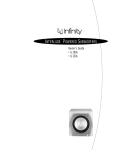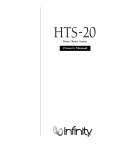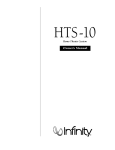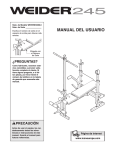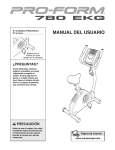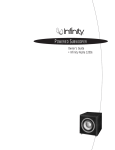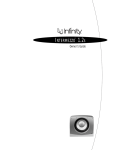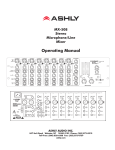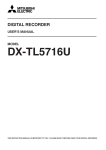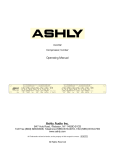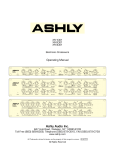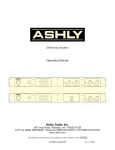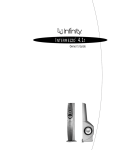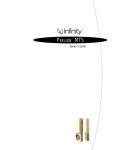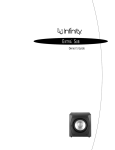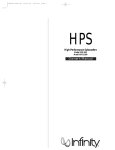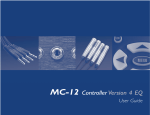Download Infinity IL 50 Main / Stereo Speaker
Transcript
INTERLUDE™ SPEAKER SYSTEMS Owner’s Guide • IL50 • IL60 CAUTION RISK OF ELECTRIC SHOCK DO NOT OPEN WARNING: SHOCK HAZARD, DO NOT OPEN. AVIS: RISQUE DE CHOC ELECTRIQUE – NE PAS OUVRIR. CUIDADO: PELIGRO DE CHOQUE ELÉCTRICO – NO ABRIR. CAUTION: TO REDUCE THE RISK OF ELECTRIC SHOCK DO NOT REMOVE COVER (0R BACK) NO USER SERVICEABLE PARTS INSIDE REFER SERVICING TO QUALIFIED PERSONNEL THIS INFINITY PRODUCT IS DESIGNED FOR 120-VOLT USE ONLY! FOR DETAILED SAFETY PRECAUTIONS, PLEASE SEE FOLLOWING PAGE IN THIS OWNER’S MANUAL FOR “IMPORTANT SAFETY INSTRUCTIONS.” The lightning flash with arrowhead symbol, within an equilateral triangle, is intended to alert the user to the presence of uninsulated “dangerous voltage” within the product’s enclosure that may be of sufficient magnitude to constitute a risk of electric shock to persons. The exclamation point within an equilateral triangle is intended to alert the user to the presence of important operating and maintenance (servicing) instructions in the literature accompanying the product. L’éclair avec le symbole de la flèche, placé dans les limites d’un triangel équilatéral est prévu pour avertir l’utilisateur de la présence de “tension dangereuse” non isolée dans l’enceinte du produit qui pourrait être d’une importance suffisante pour présenter un risque d’électrocution aux personnes. Le point d’exclamation dans un triangel équilateral est prévu pour avertir l’utilisateur de la présence d’instructions importantes pour les opérations et l’entretien (service) dans les manuels fournis avec l’appareil. ATTENTION: POUR EVITER LES CHOCS ELECTRIQUES, INTRODUIRE LA LAME LA PLUS LARGE DE LA FICHE DANS LA BORNE CORRESPONDANTE DE LA PRISE ET POUSSER JUSQUAU FOND. Este destello luminoso con un símbolo de punta de flecha dentro de un triángulo equilátero tiene el objectivo de alertar al usuario sobre la presencia de “voltaje peligroso” no aislado dentro de la caja del producto que puede ser de magnitud lo suficientemente grande para constituir un riesgo de choque eléctrico para las personas. Este punto de exclamación dentro de un triángulo equilátero tiene el objectivo de alertar al usuario sobre la existencia de instrucciones operativas y de mantenimiento (servicio) importantes en la literatura que acomaña el aparato. CUIDADO: PARA REDUCIR EL RIESGO DE CHOQUE ELÉCTRICO, NO RETIRE LA CUBIERTA (O RESPALDO). DENTRO NO HAY PEIZAS A LAS QUE EL USUARIO PUEDE DAR SERVICIO. REMITA EL SERVICIO AL PERSONAL DE SERVICIO CALIFICADO. ii INTERLUDE IMPORTANT SAFETY PRECAUTIONS Read First! CAUTION RISK OF ELECTRIC SHOCK DO NOT OPEN The lightning flash with arrowhead symbol within an equilateral triangle is intended to alert the user to the presence of uninsulated “dangerous voltage” within the product’s enclosure that may be of sufficient magnitude to constitute a risk of electric shock to persons. The exclamation point within an equilateral triangle is intended to alert the user to the presence of important operating and maintenance (servicing) instructions in the literature accompanying the appliance. 1. Read Instructions. All the safety and operating instructions should be read before the product is operated. 2. Retain Instructions. The safety and operating instructions should be retained for future reference. 3. Heed Warnings. All warnings on the product and in the operating instructions should be adhered to. 4. Follow Instructions. All operating and use instructions should be followed. 5. Cleaning. Unplug this product from the wall outlet before cleaning. Do not use liquid cleaners or aerosol cleaners. Use a damp cloth for cleaning. 6. Attachments. Do not use attachments not recommended by the product manufacturer, as they may cause hazards. 7. Water and Moisture. To reduce the risk of fire or electric shock, do not use this product outdoors or near water–for example, near a bathtub, wash bowl, kitchen sink or laundry tub; in a wet basement; near a swimming pool; or the like. 8. Accessories. Do not place this product on an unstable cart, stand, tripod, bracket or table.The product may fall, causing serious injury to a child or adult, and serious damage to the product. Use only with a cart, stand, tripod, bracket or table recommended by the manufacturer, or sold with the product. Any mounting of the product should follow the manufacturer’s instructions, and should use a mounting accessory recommended by the manufacturer. 9. A Product and Cart Combination Should Be Moved with Care. Quick stops, excessive force and uneven surfaces may cause the product and cart combination to overturn. 10. Ventilation. Slots and openings in the cabinet are provided for ventilation and to ensure reliable operation of the product and to protect it from overheating, and these openings must not be blocked or covered.The openings should never be blocked by placing the product on a bed, sofa, rug or other similar surface.This product should not be placed in a built-in installation, such as a bookcase or rack, unless proper ventilation is provided or the manufacturer’s instructions have been adhered to. 11. Power Sources. This product should be operated only from the type of power source indicated on the marking label. If you are not sure of the type of power supply to your home, consult your product dealer or local power company. For products intended to operate from battery power, or other sources, refer to the operating instructions. 12. Grounding or Polarization. This product may be equipped with a polarized alternating-current-line plug (a plug having one blade wider than the other).This plug will fit into the power outlet only one way.This is a safety feature. If you are unable to insert the plug fully into the outlet, try reversing the plug. If the plug should still fail to fit, contact your electrician to replace your obsolete outlet. Do not defeat the safety purpose of the polarized plug. 13. Power-Cord Protection. Power-supply cords should be routed so that they are not likely to be walked on or pinched by items placed upon or against them, paying particular attention to cords at plugs, convenience receptacles, and the point where they exit from the product. 14. Nonuse Periods. The power cord of the product should be unplugged from the outlet when left unused for long periods of time. 15. Outdoor Antenna Grounding. If an outside antenna or cable system is connected to the product, be sure the antenna or cable system is grounded so as to provide some protection against voltage surges and built-up static charges. Article 810 of the National Electrical Code, ANSI/NFPA 70, provides information with regard to proper grounding of the mast and supporting structure, grounding of the lead-in wire to an antenna discharge unit, size of grounding conductors, location of antenna-discharge unit, connection to grounding electrodes, and requirements for the grounding electrode. See Figure A. 16. Lightning. For added protection for this product during a lightning storm, or when it is left unattended and unused for long periods of time, unplug it from the wall outlet and disconnect the antenna or cable system.This will prevent damage to the product due to lightning and power-line surges. 17. Power Lines. An outside antenna system should not be located in the vicinity of overhead power lines or other electric light or power circuits, or where it can fall into such power lines or circuits. When installing an outside antenna system, extreme care should be taken to keep from touching such power lines or circuits, as contact with them might be fatal. Figure A. Example of Antenna Grounding as per National Electrical Code ANSI/NFPA 70 18. Overloading. Do not overload wall outlets, extension cords, or integral convenience receptacles, as this can result in a risk of fire or electric shock. 19. Object and Liquid Entry. Never push objects of any kind into this product through openings, as they may touch dangerous voltage points or short-out parts that could result in a fire or electric shock. Never spill liquid of any kind on the product. 20. Servicing. Do not attempt to service this product yourself, as opening or removing covers may expose you to dangerous voltage or other hazards. Refer all servicing to qualified service personnel. 21. Damage Requiring Service. Unplug this product from the wall outlet and refer servicing to qualified service personnel under the following conditions: a. The power-supply cord or the plug has been damaged; or b. Objects have fallen onto, or liquid has been spilled into, the product; or c. The product has been exposed to rain or water; or d. The product does not operate normally when following the operating instructions. Adjust only those controls that are covered by the operating instructions, as an improper adjustment of other controls may result in damage and will often require extensive work by a qualified technician to restore the product to its normal operation; or e. The product has been dropped or damaged in any way; or f. The product exhibits a distinct change in performance; this indicates a need for service. 22. Replacement Parts. When replacement parts are required, be sure the service technician has used replacement parts specified by the manufacturer or that have the same characteristics as the original part. Unauthorized substitutions may result in fire, electric shock or other hazards. 23. Safety Check. Upon completion of any service or repairs to this product, ask the service technician to perform safety checks to determine that the product is in proper operating condition. 24. Wall or Ceiling Mounting. The product should be mounted to a wall or ceiling only as recommended by the manufacturer. 25. Heat. The product should be situated away from heat sources such as radiators, heat registers, stoves or other products (including amplifiers) that produce heat. Antenna Lead-In Wire Ground Clamp Antenna Discharge Unit (NEC Section 810-20) Grounding Conductors (NEC Section 810-21) Electric Service Equipment Ground Clamps Power Service Grounding Electrode System (NEC Art. 250, Part H) INTERLUDE iii IL50 & IL60 OWNER’S GUIDE Table of Contents ii Caution iii Important Safety Precautions 1 Unpacking the Speakers/Included Accessories 1 Installing Feet 2 Placement 3 Controls and Connections 4 Connection Methods 1–4 7 Operation 7 Bass Optimization System™ 8 Maintenance and Service 9 Specifications 10 iv INTERLUDE Notes Infinity Interlude Series The Interlude Series of loudspeakers continues Infinity’s longstanding commitment to accurate sound reproduction. Our proprietary Ceramic Metal Matrix Diaphragm™ (C.M.M.D.™) drivers, precision dividing networks and rigid, well-braced enclosures combine to deliver uncompromised performance in any stereo or multichannel home-theater system. In addition, the IL50 and IL60 incorporate Infinity’s proprietary Bass Optimization System, which allows you to easily and precisely fine-tune the speaker’s built-in powered subwoofers for optimum performance in your listening room. Also, both models are magnetically shielded for safe placement adjacent to a television. UNPACKING THE SPEAKERS If you suspect damage from transit, report it immediately to your dealer. Keep the shipping carton and packing materials for future use. Included Accessories . . . INSTALLING FEET Refer to Figure 1 as you perform the following steps: 1. Open each accessory pack and locate the following items: four feet (with spike/round ends), four locking nuts, four nylon domes and one wrench. 2. Lay each speaker on its side and locate the four threaded holes on the bottom. 3. For carpets, screw the round end of a foot into each hole and hand-tighten a nut onto each one. Leave a minimum of 5/8" of exposed spike. (On thicker carpets, you can increase the length of exposed spike up to 1-1/8.") For hard-surface floors, screw the spike end into each hole instead and leave 5/8" of round end exposed. 4. Carefully flip each speaker upright to sit on its feet. 5. If needed, adjust the feet so each speaker is level and then tighten each nut with the enclosed wrench.To protect hard surfaces (e.g., wood floors), slip a nylon dome onto each round end. Spikes Bottom of Speaker Locking Nut 5 ⁄ 8" min. 5 ⁄ 8" Foot 11 ⁄ 8" max. round end spike end Nylon Dome (optional for wood floors) Bass Optimization System Adjustment Screwdriver CARPETED FLOORS HARD-SURFACE FLOORS FIGURE 1 – This cross section shows how to install a foot onto the bottom of an IL50 or IL60 floorstanding speaker. INTERLUDE 1 PLACEMENT Stereo Before deciding where to place your Interlude speakers, survey your room and think about placement, keeping the following points in mind: Right Channel Left Channel • For best results, place the speakers 6'– 8' apart. • Position each speaker so that the tweeter is approximately at ear level. • Generally, bass output will increase as the speaker is moved closer to a wall or corner. • Refer to “Home Theater” below if you also plan to use the speakers for home-theater reproduction. Listening Position Home Theater For front-channel use, place one speaker on the left and another on the right along either side of the television monitor. Since the speakers are magnetically shielded, you can place them close to the TV without worrying about the magnetic field distorting the TV picture. FIGURE 2 – Experiment with speaker placement to obtain the best bass level and stereo imaging in your room. Front Left Channel Left Surround Channel FIGURE 3 2 INTERLUDE Center Channel Listening Position Front Right Channel Right Surround Channel – This overhead view shows a typical home-theater plan. CONTROLS AND CONNECTIONS Front Panel Rear Panel Sub Input Subwoofer Line Level In Out Low-Pass Filter On Bass Optimization System On Line Level Off Off 3 4 Speaker 8 1 2 Speaker Level – 5 + 3A 120V – 60HZ 3A 250V Freq. 9 Level J Width K POWER On ¢› 6 CAUTION Off L 7 RISK OF ELECTRIC SHOCK DO NOT OPEN 1 Subwoofer Line-Level-In Connector L Subwoofer Level Control 2 Subwoofer Line-Level-Out Connector 3 Subwoofer Input Selector 4 Low-Pass Filter Switch 5 Speaker-Level Input 6 AC-Cord Input 7 Power Switch Bass Optimization System 8 Bass Optimization System Selector 9 Center-Frequency Adjustment J Bass Optimization System Level K Bandwidth Adjustment INTERLUDE 3 System Type The Interlude IL50 and IL60 offer unprecedented flexibility for connecting the system to any type of audio or home-theater system. Consult the table at right to determine which system description most closely matches your own, then follow the hook-up method corresponding to that system. If none of these system configurations seem to match yours, consult your dealer or Infinity customer service for direction on how best to hook up your system. For Methods 2, 3a, 3b and 4, make sure all bass-management features are properly set.The Audio channels should all be set to “Small” or “High-Pass” and the subwoofer set to “On.” RED = + Connection Methods 2-Channel receiver or integrated amplifier that has no subwoofer output or Pre-out/Main-In connectors 1 2-Channel receiver or integrated amplifier with preamp output and input connectors 2 2-Channel system with separate preamplifier and power amplifier 2 Dolby* Pro Logic* with THX®, Dolby Digital, or DTS® receiver with a filtered subwoofer (or LFE) output connector 3a Dolby Digital or DTS processor with separate power amplifiers or multichannel amplifier 3b Non-THX certified Dolby Pro Logic receiver with full-range subwoofer outputs 4 Method 1 BLACK = – Sub Input Subwoofer Line Level 1. LOOSEN TERMINALS In 2. INSERT BARE END; TIGHTEN TERMINALS Out Speaker Line Level (ONE CHANNEL SHOWN) 3. SET SUB INPUT 3 TO “SPEAKER” NO STRIPE = Low-Pass Filter On Bass Optimization System On Off Off AMPLIFIER/RECEIVER – STRIPE = 4. SET LOW-PASS FILTER 4 ON Speaker Level SPEAKER OUTPUTS + + – – Freq. Level + – + Width 3A 120V – 60HZ 3A 250V POWER On Off AC CORD CAUTION RISK OF ELECTRIC SHOCK DO NOT OPEN Method 2 RED = + In BLACK = Out Speaker – Line Level AMPLIFIER/RECEIVER SPEAKER OUTPUTS 1. LOOSEN TERMINALS + – – LEFT NO STRIPE = – STRIPE = Low-Pass Filter On Bass Optimization System On Off Off Speaker Level SPEAKER OUTPUTS 2. INSERT BARE END; TIGHTEN TERMINALS 3. SET SUB INPUT 3 TO “LINE LEVEL” Sub Input Subwoofer Line Level Freq. Level + RIGHT – + Width + 4. SET LOW-PASS FILTER 4 “ON” 3A 250V POWER On Off AC CORD CAUTION RISK OF ELECTRIC SHOCK DO NOT OPEN (ONE CHANNEL SHOWN) PREAMP OUTPUTS L AMPLIFIER INPUTS L R R 4 INTERLUDE RED = Method 3a + Sub Input Subwoofer Line Level BLACK = In – Speaker Line Level (ONE CHANNEL SHOWN) 1. LOOSEN TERMINALS SURROUND RECEIVER SUBWOOFER (LFE) OUTPUT 2. INSERT BARE END; TIGHTEN TERMINALS 3. SET SUB INPUT 3 TO “LINE LEVEL” Out NO STRIPE = – STRIPE = FRONT SPEAKER OUTPUTS Off Off Speaker Level Freq. Level – TO SECOND IL50/IL60 Bass Optimization System On + – + Low-Pass Filter On + Width Y-Connector 4. SET LOW-PASS FILTER 4 TO “OFF” 3A 250V POWER On Off AC CORD CAUTION RISK OF ELECTRIC SHOCK DO NOT OPEN RED = + (ONE CHANNEL SHOWN) AMPLIFIER Method 3b BLACK = SPEAKER OUTPUT – – + PROCESSOR FRONT CHANNEL OUTPUT L INPUT SUBWOOFER (LFE) OUTPUT L R R 1. LOOSEN TERMINALS 2. INSERT BARE END; TIGHTEN TERMINALS 3. SET SUB INPUT 3 TO “LINE LEVEL” Y-Connector TO SECOND IL50/IL60 NO STRIPE = – STRIPE = + Sub Input Subwoofer Line Level In Out 4. SET LOW-PASS FILTER 4 TO “OFF” Speaker Line Level Low-Pass Filter On Bass Optimization System On Off Off Speaker Level Freq. Level – + Width 3A 250V POWER On Off AC CORD CAUTION RISK OF ELECTRIC SHOCK DO NOT OPEN INTERLUDE 5 RED = Method 4 + (ONE CHANNEL SHOWN) BLACK = – RECEIVER SPEAKER OUTPUTS SUBWOOFER OUTPUTS 1. LOOSEN TERMINAL – + L 2. INSERT BARE END; TIGHTEN TERMINAL 3. SET SUB INPUT 3 TO “LINE LEVEL” R NO STRIPE = – STRIPE = RIGHT + Sub Input Subwoofer Line Level In Out 4. SET LOW-PASS FILTER 4 TO “ON” Speaker Line Level Low-Pass Filter On Bass Optimization System On Off Off Speaker Level Freq. Level – + Width 3A 250V POWER On Off AC CORD CAUTION RISK OF ELECTRIC SHOCK DO NOT OPEN Final Positioning After correctly connecting the loudspeaker and verifying that both the subwoofer and main section portions are playing, it is time to optimize the system for your particular listening room. Earlier, you placed the loudspeakers in their general location. Finding the exact location for optimum performance sometimes only involves moving the speakers a few inches in any direction. We urge you, therefore, to experiment with placement until your speakers deliver their full potential. When the speakers are moved inward (toward each other) there is generally better focus of instruments and vocalists; however, moving the speakers too close together can reduce the spaciousness of the stage effect and you may need to experiment with the trade-off between focus and imaging. If your listening room is larger than average and your listening position is relatively far from the speakers, wider placement of the speakers may be required. 6 INTERLUDE OPERATION Power On Plug your speakers’AC cords into a wall outlet. Do not use the outlets on the back of the receiver. Initially set the subwoofer Level Controls L to the “O” position. Turn on your subwoofers by pressing the power buttons 7 on the rear panel of the speakers. Turn on your entire audio system and start a CD or movie soundtrack at a moderate level. Adjust Gain Turn both subwoofer Level Controls L up to the “5” position (half way). If no sound emanates from the subwoofers, check the AC-line cords and input cables.Are the connectors on the cables making proper contact? Are the AC plugs connected to “live” receptacles? Have the power buttons 7 been pressed to the “On” position? (Note:The Level Control on the front panel will turn green when the power is on and there is a signal present. After about ten minutes with no audio signal, the indicator will turn red.) Once you have confirmed that the subwoofers are active, proceed by playing a CD, record or cassette. Use a selection that has ample bass information. Set the overall volume control of the preamplifier or stereo to a comfortable level. Adjust the subwoofer Level Controls L until you obtain a pleasing blend of bass. Bass response should not overpower the room but rather be adjusted so there is a harmonious blend across the entire musical range. Many users have a tendency to set subwoofer volume too loud, adhering to the belief that a subwoofer is there to produce lots of bass. This is not entirely true. A subwoofer is there to enhance bass, extending the response of the entire system so the bass can be felt as well as heard. However, overall balance must be maintained or the music will not sound natural. An experienced listener will set the volume of the subwoofer so its impact on bass response is always there but never obtrusive. BASS OPTIMIZATION SYSTEM™ Infinity’s Bass Optimization System is a simple-to-use, yet sophisticated, low-frequency calibration system. Each Interlude IL50 or IL60 subwoofer contains a parametric equalizer that you can adjust by following the directions below. By following these instructions, you can improve the sound of your system. The Bass Optimization System Goal It is a fact of audio that what we hear at low frequencies is determined as much or more by the listening room than by the loudspeaker itself. Placement of the loudspeakers and listeners and the acoustical characteristics of the room surfaces are all important determinants of bass quantity and quality. In most practical situations, there is little that can be done about this, except for patient trial-and-error repositioning of the loudspeakers and listeners. Usually, the practical constraints of a living space and the impracticality of massive acoustical treatment mean that equalization is the only practical solution. Professional sound engineers routinely employ sophisticated measurement systems and equalizers to optimize speakers to the installation.This was never practical for the home audiophile. This is why the Bass Optimization System was created. It enables you to identify the dominant low-frequency response characteristic of your room. Once you know the problem, the Bass Optimization System provides the tools needed to optimize the low-frequency characteristics of the speakers to the room they are in, exactly as the professional sound engineers do it. Preparations Before beginning the bass tests, please check the following: • Make sure all three Bass Optimization System controls, 9, J and K, on both speakers are turned fully clockwise. • Make sure the loudness contour (if any) on your receiver/ processor/preamp is turned off. • Set the tone controls (Bass and Treble) to their center or flat positions. • Bypass all surround and effects features of your receiver/ processor/preamp or set to Stereo Bypass. • If you are using a multichannel surround processor or receiver, make sure all bass-management features are properly set.The Audio channels should all be set to “Small” or “HighPass” and the subwoofer set to “On.” • Set the Bass Optimization System selectors 8 to “On.” For best results, it is recommended that all major furnishings are in place and that all doors and windows in the listening area are in their normal positions.That is, if you normally listen to music with all doors closed, then this is how they should be during this procedure. To solve a problem, it helps to first identify whether you have one and, if so, what it is. First, play a variety of music and films with energetic bass sounds, like bass guitar, kick drum, keyboards, etc. A kick drum should produce a tight “thump” , not a flabby “boom.” Bass melody or harmony lines should have notes that are about equally loud. If some notes disappear, or stand out because they are consistently too loud, there is a problem. Disappearing notes have to be handled by moving the listening position, or the loudspeakers, to slightly different locations. Often, but not always, this will be enough. Excesses in bass tend to be most annoying, and energetic resonances that cause “boomy” or “lumpy” bass can be truly aggravating over a period of time. Infinity’s Bass Optimization System can fix this. So, the first step is to exercise your music collection, and listen for low-frequency problems that crop up in several different recordings. Something that only happens in one recording is likely to be a problem in the recording – it happens! If you identify something that is consistently wrong, select a record that shows it very clearly, and put your CD/DVD player into a repeat mode (A-B repeat is especially helpful, because you can isolate a short musical passage). INTERLUDE 7 NOTE: It is important that you make the same adjustments to both loudspeakers. Set the Bass Optimization System Bandwidth adjustments K to a middle position (10 clicks from a fully clockwise position) and set Level adjustments J for a –6dB (8 clicks from a fully clockwise position).Then, while the music is playing, sit in your favorite chair and have somebody else slowly adjust the Frequency controls 9 from fully clockwise to fully counterclockwise. At a certain frequency, you should hear the problem lessen and the overall bass performance improve. When you are satisfied that you have found the best frequency, have your assistant vary the Levels J slowly up and down until you have maximized the improvement. If you have really keen ears, you can also have the Bandwidth controls K adjusted for maximum benefit. While the Bass Optimization System allows the listener to finetune the bass response to sound best in a particular room, some listeners don’t have the skill or desire to adjust their system by ear. In order to facilitate quicker and more accurate results, Infinity has developed an optional test and measurement kit that allows the user to perform a series of measurements and aids him/her in properly setting the Bass Optimization System controls. With the addition of this kit, the Bass Optimization System becomes truly room-adaptive. The kit consists of the following: a test CD, a sound-level meter that is specifically calibrated for low frequencies, and something we call a “Q-Finder,”a device to help find the width of the measured curve and, finally, a measurement template. It works as follows.The listener plays the tones from the test CD and records the relative output level of each test tone, using the sound-level meter, on the provided measurement template. After all the tones are complete, the template contains a response curve for the frequencies below 100Hz.The user simply notes the frequency of the largest bass peak, calculates the correct amount of attenuation, and uses the “Q-Finder”to determine the width of the curve.These three values are dialed into the Bass Optimization System controls located on the speaker.The entire process takes less than twenty minutes. If your dealer does not stock the Bass Optimization System test and measurement kit, you may purchase it directly from Infinity. U.S. residents can visit our Web site at www.infinitysystems.com or call 1-800-553-3332. Canadian residents should contact their dealer or call 1-800-567-3275. 8 INTERLUDE MAINTENANCE AND SERVICE The enclosure may be cleaned using a soft cloth, dampened with water only, to remove fingerprints or to wipe off dust. The grille may be gently vacuumed. Stains may be removed with an aerosol cleaner, following its instructions. Do not use any solvents on the grille. All wiring connections should be inspected and cleaned or remade periodically.The frequency of maintenance depends on the metals involved in the connections, atmospheric conditions, and other factors, but once per year is the minimum. If a problem occurs, make sure that all connections are properly made and clean. If a problem exists in one loudspeaker, reverse the connection wires to the left and right system. If the problem remains in the same speaker, then the fault is with the loudspeaker. If the problem appears in the opposite speaker, the cause is in another component or cable. In the event that your Interlude loudspeaker system ever needs service, contact your local Infinity dealer or Infinity directly at 1-800-553-3332 or www.infinitysystems.com for a service center near you. SPECIFICATIONS IL50 IL60 Frequency Range: 32Hz – 22,000Hz (±3dB) 28Hz – 22,000Hz (±3dB) Recommended Amplifier Power Range: 15 – 150 watts 15 – 175 watts Subwoofer Amplifier Output: 250 watts 500 watts 88dB 89dB Nominal Impedance: 8Ω 8Ω Crossover Frequency: 150Hz, 2500Hz; 24dB/octave 150Hz, 500Hz, 2800Hz; 24dB/octave Low-Frequency Driver: 10" C.M.M.D., magnetically shielded 12" C.M.M.D., magnetically shielded Mid-Bass Driver: 6-1/2" C.M.M.D., magnetically shielded 6-1/2" C.M.M.D., magnetically shielded Midrange Driver: N/A 4" C.M.M.D., magnetically shielded High-Frequency Driver: 1" C.M.M.D., magnetically shielded 1" C.M.M.D., magnetically shielded Dimensions (H x W x D): 42" x 8-3/4" x 14-1/2" (1067mm x 222mm x 368mm) 48" x 9-1/4" x 17-1/4" (1219mm x 235mm x 438mm) Weight: 60 lb (27kg) 75 lb (34kg) (In to 8Ω from 20Hz – 100Hz with no more than 0.1% THD) Sensitivity: (2.83V @ 1 meter) Infinity continually strives to update and improve existing products as well as create new ones.The specifications and construction details in this and related Infinity publications are therefore subject to change without notice. INTERLUDE 9 Notes: 10 INTERLUDE Notes: INTERLUDE 11 © 2000 Infinity Systems, Inc., 250 Crossways Park Drive, Woodbury, NY 11797 USA (800) 553-3332 (USA Only) www.infinitysystems.com *Trademarks of Dolby Laboratories.THX is a registered trademark of Lucasfilm, Ltd. DTS is a registered trademark of Digital Theater Systems, Inc. Infinity is a registered trademark of Infinity Systems, Inc. Printed in USA 3/00 Part No. 335832-001
















